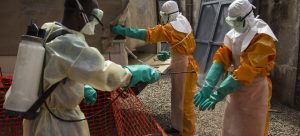Ebola Outbreak:

The Democratic Republic of Congo declared the end of an Ebola outbreak that infected 12 people in the eastern province of North Kivu and killed six of them.
- The outbreak was contained using Merck’s Ebola vaccine, which was given to more than 1,600 of the patients’ contacts and contacts of contacts.
- The cases were genetically linked to the 2018-20 Ebola epidemic that killed more than 2,200 People, the second-highest toll recorded in the disease’s history.
- Ebola virus disease (EVD), formerly known as Ebola haemorrhagic fever, is a severe, often fatal illness in humans.
- Virus species: The virus family Filoviridae includes three genera: Cuevavirus, Marburgvirus, and Ebolavirus. Within the genus Ebolavirus, five species have been identified: Zaire, Bundibugyo, Sudan, Reston and Tai Forest.
- The virus is transmitted to people from wild animals such as chimpanzees, gorillas, fruit bats) and then spreads in the human population through human-to-human transmission.
- It is thought that fruit bats of the Pteropodidae family are natural Ebola virus hosts.
- People can get the virus through sexual contact as well.
- The average EVD case fatality rate is around 50%. Case fatality rates have varied from 25% to 90% in past outbreaks.
- Early supportive care with rehydration, symptomatic treatment improves survival. There is as yet no licensed treatment proven to neutralize the virus but a range of blood, immunological and drug therapies are under development.




